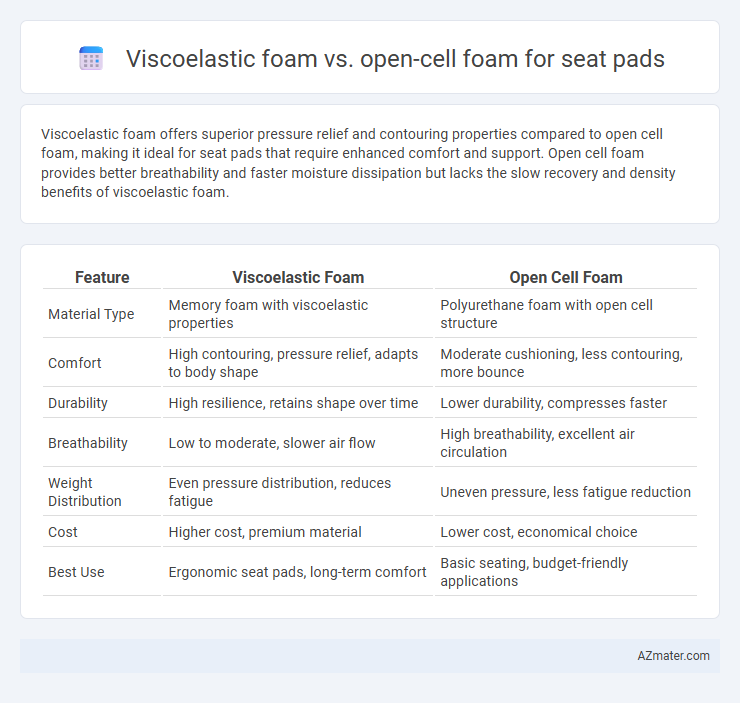Viscoelastic foam offers superior pressure relief and contouring properties compared to open cell foam, making it ideal for seat pads that require enhanced comfort and support. Open cell foam provides better breathability and faster moisture dissipation but lacks the slow recovery and density benefits of viscoelastic foam.
Table of Comparison
| Feature | Viscoelastic Foam | Open Cell Foam |
|---|---|---|
| Material Type | Memory foam with viscoelastic properties | Polyurethane foam with open cell structure |
| Comfort | High contouring, pressure relief, adapts to body shape | Moderate cushioning, less contouring, more bounce |
| Durability | High resilience, retains shape over time | Lower durability, compresses faster |
| Breathability | Low to moderate, slower air flow | High breathability, excellent air circulation |
| Weight Distribution | Even pressure distribution, reduces fatigue | Uneven pressure, less fatigue reduction |
| Cost | Higher cost, premium material | Lower cost, economical choice |
| Best Use | Ergonomic seat pads, long-term comfort | Basic seating, budget-friendly applications |
Introduction to Seat Pad Materials
Viscoelastic foam adapts to body contours by responding to heat and pressure, offering superior pressure relief and support for seat pads. Open cell foam features a porous structure that provides breathability and lightweight cushioning but may lack the same level of durability and contouring properties. Selecting the right seat pad material depends on balancing comfort, breathability, and long-term support requirements.
What is Viscoelastic Foam?
Viscoelastic foam, also known as memory foam, is a high-density polyurethane material characterized by its pressure-sensitive properties and slow recovery rate, providing superior contouring and support for seat pads. Unlike open cell foam, which features a porous structure allowing for better airflow and lighter weight, viscoelastic foam excels in reducing pressure points and improving comfort by molding to the body's shape. This makes viscoelastic foam ideal for ergonomic seating applications where prolonged comfort and pressure relief are critical.
Understanding Open Cell Foam
Open cell foam for seat pads offers enhanced breathability and superior air circulation due to its porous structure, which helps reduce heat buildup and moisture retention. It provides a softer, more cushioning feel with greater flexibility, making it ideal for short-term seating comfort. Compared to viscoelastic foam, open cell foam delivers quicker recovery and less density, contributing to a lighter and more breathable seating experience.
Comfort Comparison: Viscoelastic vs Open Cell Foam
Viscoelastic foam offers superior pressure distribution and body contouring, providing enhanced comfort by reducing pressure points in seat pads. Open cell foam features higher breathability and faster air circulation, which helps maintain a cooler seating experience but may lack the adaptive support of viscoelastic foam. The choice between viscoelastic and open cell foam depends on prioritizing cushioning responsiveness versus ventilation in seat pad comfort.
Pressure Relief and Support Differences
Viscoelastic foam, also known as memory foam, excels in pressure relief by conforming closely to body contours and evenly distributing weight, reducing pressure points significantly. Open cell foam provides more breathable support with quicker responsiveness, offering a firmer feel that maintains spinal alignment without the deep sink characteristic of viscoelastic foam. For seat pads, viscoelastic foam is ideal for prolonged sitting due to superior pressure distribution, while open cell foam is better for those needing enhanced ventilation and firmer support.
Durability and Lifespan
Viscoelastic foam offers superior durability and a longer lifespan compared to open cell foam due to its higher density and ability to retain shape under prolonged pressure. Open cell foam tends to degrade faster as its structure collapses more easily, leading to reduced support and comfort over time. Choosing viscoelastic foam for seat pads results in extended usability and better long-term performance.
Breathability and Temperature Regulation
Viscoelastic foam offers moderate breathability due to its dense structure, often retaining heat which can cause discomfort during extended use. Open cell foam excels in breathability with its interconnected porous design, promoting better air circulation and effective temperature regulation. For seat pads, open cell foam is generally preferred in warmer environments, while viscoelastic foam suits settings where pressure relief is prioritized over cooling.
Weight and Portability Factors
Viscoelastic foam, known for its higher density typically ranging from 3 to 6 pounds per cubic foot, provides superior comfort but adds significant weight to seat pads, impacting portability. Open cell foam, with a lower density around 1 to 2 pounds per cubic foot, offers lightweight and breathable cushioning that enhances ease of transport without sacrificing basic comfort. Selecting between these foams depends on balancing the need for durable support against the convenience of lightweight portability in seat pad applications.
Cost Analysis: Viscoelastic vs Open Cell Foam
Viscoelastic foam typically incurs higher costs than open cell foam due to its advanced memory and pressure-relieving properties, which require more complex manufacturing processes and premium raw materials. Open cell foam offers a cost-effective alternative with lower material and production expenses, making it suitable for budget-conscious seat pad applications. Evaluating long-term durability and comfort benefits against initial price differences is crucial for an accurate cost analysis between viscoelastic and open cell foam.
Which Foam is Best for Your Seat Pad?
Viscoelastic foam offers superior pressure relief and contouring properties, making it ideal for seat pads that require enhanced comfort and support during prolonged sitting. Open cell foam, characterized by its breathability and lightweight structure, provides better airflow and moisture management but may lack the same level of cushioning and durability as viscoelastic foam. For seat pads prioritizing ergonomic support and long-term comfort, viscoelastic foam is generally the best choice, while open cell foam suits applications where ventilation and lighter weight are more critical.

Infographic: Viscoelastic foam vs Open cell foam for Seat pad
 azmater.com
azmater.com